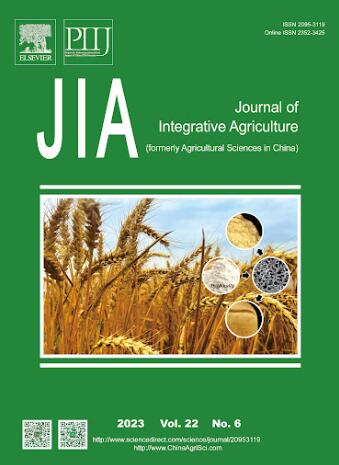基于无人机遥感的 CWSI 和 Ts-Ta-VI 在旱地作物(高粱、玉米)水分监测中的比较
IF 4.4
1区 农林科学
Q1 AGRICULTURE, MULTIDISCIPLINARY
引用次数: 0
摘要
利用遥感数据监测农业干旱对于现代农业的精准灌溉至关重要。本研究利用无人飞行器(UAV)遥感技术,探索了基于冠层温度的经验作物水分胁迫指数(CWSI)和由地表温度()、空气温度()和五个植被指数(VIs)构建的三维干旱指数(TDDI)在监测旱地作物水分状况方面的适用性。研究采用了三种机器学习算法(随机森林回归、支持向量回归和偏最小二乘回归)来比较干旱指数在估算高粱和玉米植被含水量(VMC)方面的性能。研究的主要结果如下:(1) 干旱指数的比较分析表明,归一化差异植被指数(TDDIn)和增强植被指数(TDDDIe)与植被含水量的相关性比其他指数更强。(2) 在时空特征方面,TDDIn、TDDDIe 和 CWSI 指数在试验期间的差异极小,变异系数分别为 0.25、0.18 和 0.24。这三个指数都能有效描述旱地玉米和高粱作物的水分分布特征,但 TDDI 指数能更准确地监测降雨或灌溉事件后作物水分的空间分布。(3) 在预测单一作物的水分含量时,基于 TDDIn 和 TDDDIe 的 RFR 模型对 VMC 的估算最为准确(0.7),而在考虑多作物样本时,基于 TDDIn 的模型预测 VMC 的准确度最高,均方根误差分别为 0.62% 和 14.26%。因此,在估算作物含水量方面,TDDDI 比 CWSI 更有效。本文章由计算机程序翻译,如有差异,请以英文原文为准。
Comparison of CWSI and Ts-Ta-VIs in moisture monitoring of dryland crops (sorghum, maize) based on UAV remote sensing
Monitoring agricultural drought using remote sensing data is crucial for precision irrigation in modern agriculture. Utilizing unmanned aerial vehicle (UAV) remote sensing, this study explored the applicability of an empirical crop water stress index (CWSI) based on canopy temperature and three-dimensional drought indices (TDDI) constructed from surface temperature (), air temperature () and five vegetation indices (VIs) for monitoring the moisture status of dryland crops. Three machine learning algorithms (random forest regression [RFR], support vector regression, and partial least squares regression) were used to compare the performance of the drought indices for vegetation moisture content (VMC) estimation in sorghum and maize. The main results of the study were as follows: (1) Comparative analysis of the drought indices revealed that --Normalized Difference Vegetation Index (TDDIn) and --Enhanced Vegetation Index (TDDIe) were more strongly correlated with VMC compared with the other indices. The indices exhibited varying sensitivities to VMC under different irrigation regimes; the strongest correlation observed was for the TDDIe index with maize under the fully irrigated treatment (=−0.93); (2) Regarding spatial and temporal characteristics, the TDDIn, TDDIe and CWSI indices showed minimal differences over the experimental period, with coefficients of variation were 0.25, 0.18 and 0.24, respectively. All three indices were capable of effectively characterizing the moisture distribution in dryland maize and sorghum crops, but the TDDI indices more accurately monitored the spatial distribution of crop moisture after a rainfall or irrigation event. (3) For prediction of the moisture content of single crops, RFR models based on TDDIn and TDDIe estimated VMC most accurately (0.7), and the TDDIn-based model predicted VMC with the highest accuracy when considering multiple-crop samples, with and RMSE of 0.62 and 14.26%, respectively. Thus, TDDI proved more effective than the CWSI in estimating crop water content.
求助全文
通过发布文献求助,成功后即可免费获取论文全文。
去求助
来源期刊

Journal of Integrative Agriculture
AGRICULTURE, MULTIDISCIPLINARY-
CiteScore
7.90
自引率
4.20%
发文量
4817
审稿时长
3-6 weeks
期刊介绍:
Journal of Integrative Agriculture publishes manuscripts in the categories of Commentary, Review, Research Article, Letter and Short Communication, focusing on the core subjects: Crop Genetics & Breeding, Germplasm Resources, Physiology, Biochemistry, Cultivation, Tillage, Plant Protection, Animal Science, Veterinary Science, Soil and Fertilization, Irrigation, Plant Nutrition, Agro-Environment & Ecology, Bio-material and Bio-energy, Food Science, Agricultural Economics and Management, Agricultural Information Science.
 求助内容:
求助内容: 应助结果提醒方式:
应助结果提醒方式:


